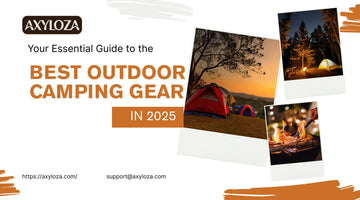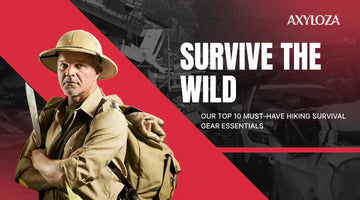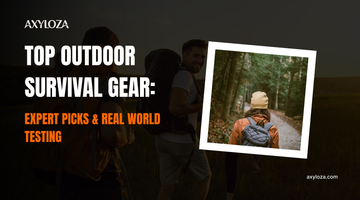Planning your next wilderness trip? The right outdoor survival gear can make all the difference. In 2025, it’s not just about what you carry, it’s about what actually works, weighs less, and lasts longer.
Over the next few sections, we’ll walk through must-haves in a survival gear list, innovations changing the game, and how to choose gear that fits your adventures, whether you’re urban camping, hiking, or deep in remote terrains.
Must‑Have Gear Essentials for 2025
Putting together an essential survival gear kit means covering basics first. Without certain tools, the smallest trip can become risky.
- Shelter & Sleep System: A solid tent, footprint, and sleeping bag rated for your climate. In 2025, ultralight backpacking tents and four‑season sleeping bags are innovative.
- Water Purification & Filtration: Gravity filters, UV purifiers, portable filters removing bacteria and microplastics.
- Fire and Cooking Tools: Portable stoves (including biomass and solar powered), fire starters, lightweight pots/pans. In 2025, stoves that double as charging stations are trending.
- Lighting & Power: Headlamps, solar lanterns, portable power stations, solar chargers. Devices that are waterproof, durable, and with longer battery life are in demand.
-
Navigation & Safety: Map & compass, GPS or satellite communicator, whistle, first‑aid supplies. The trend is toward smarter safety devices with better power efficiency.
These essentials form the backbone of the survival camping gear list you build. They ensure you're prepared for the basics: shelter, water, warmth, safety.
Innovations & Trends in Outdoor Gear 2025

Every year, gear evolves. This year, the biggest changes are in sustainability, multifunctionality, and lightweight design. Here’s what’s new.
- Sustainable Materials: Gear made of recycled plastics, bio‑based fabrics, fully recyclable sleeping bags, and backpacks.
- Multi‑functional Tools: Tents that set up fast (modular tents, quick frame designs), jackets that convert into emergency sleep quilts, gear that does double duty (lamp + power bank, etc.)
- Weight & Packability Gains: Ultralight backpacking gear, compressible pads, lighter insulation without sacrificing warmth.
-
Smart Power & Off‑Grid Tech: Portable solar chargers, durable lithium battery packs, power systems integrating multiple charging inputs, and gear that helps you stay connected even off the grid.
These trends help you build a survival gear kit that lasts, doesn’t weigh you down, and works when you need it most.
How to Pick Gear According to Your Adventure Type?
Not all camping is the same. What you need for weekend family camping is different from what you need for alpine hiking or ride‑along motorcycle adventures.
|
Adventure Type |
Key Gear Priorities |
What to Emphasize |
|
Car camping/family trips |
Comfort, space, cooking tools |
Big tent, quality lanterns, roomy sleeping bags |
|
Backpacking / ultralight hiking |
Weight, packability, essentials |
Ultralight shelter, compact stove, minimal kitchen |
|
Adventure bike/motorcycle riding |
Durability, protection, modular storage |
Rugged gear, waterproof bags, gear that mounts easily |
|
Urban survival/emergency prep |
Versatility, portability, quick deployment |
Compact kit, multi-tools, emergency shelter & water |
If you plan to combine activities (say hiking + bike riding), your adventure gear needs to balance these priorities.
Best Brands & Durability Considerations
Choosing the best outdoor gear brands isn’t just about name recognition; it’s about reliability, warranties, and tested performance in harsh conditions.
- Brands offering lifetime warranties, repair programs, or recyclable gear score higher these days.
- Look for gear with real field‑testing, gear that pros have pushed through storms, cold nights, heavy use, etc.
-
Materials matter: rip‑stop fabrics, water‑resistant coatings, lightweight but robust zippers, sturdy poles or frames.
Trust the brands that invest in sustainability and durability. It’s often worth spending more up front for gear that doesn’t fail when it counts.
Packing & Building Your Survival Gear List

Here’s a rough survival gear list you can adapt. Combine with your adventure type and the trends above.
Sample Survival Gear List for a 3‑Day Backpacking Trip
- Ultralight tent (2‑person)
- Sleeping bag (3‑season) + sleeping pad
- Backpack (30‑50L)
- Portable stove + fuel/biomass stove option
- Water filter or purifier + backup method
- Headlamp + spare batteries
- First aid kit
- Multifunction knife / multi‑tool
- Fire starting kit (matches, lighter, ferro rod)
- Clothing layers (insulation + rain layer)
- Navigation tools (map, compass, GPS device)
- Cordage/repair kit
- Emergency blanket or tarp
- Food & cooking kit
-
Signaling tools (whistle, mirror)
Having this kind of camping and survival gear packed appropriately means fewer surprises when conditions get tough.
Product Details
Here are features to prioritize in your picks. These specs help with the necessary survival gear that doesn’t look pretty only on paper; it performs.
-
Weather‑proof materials: waterproof fabrics, sealed seams, rust‑proof components
-
Lightweight construction without compromising durability (e.g., ultralight tents with strong poles)
-
Sustainability features: recycled materials, repairability, minimal packaging
-
Multifunctionality: gear that does more than one job (e.g., pot + pan cook set, jacket + sleep liner)
-
Warranty/customer support: brands that stand behind their products
Urban vs Wilderness: What’s Different?
Your demands change depending on whether you’re venturing into remote wilderness or just preparing for emergencies in urban settings.
- Urban survival gear tends to favor compactness, concealment, and ease of deployment. Think compact water purification, blackout shelters, and small multitools.
-
Wilderness gear demands ruggedness, larger shelters, better insulation, more robust cooking systems, and long‑lasting energy sources.
Your gear list should lean toward what environment you expect, so you’re not carrying unnecessary bulk, or worse, missing critical survival tools.
Conclusion
Outdoor survival gear in 2025 is smarter, lighter, and more durable than ever. The camping survival gear you choose should match your adventure type, climate, and your own readiness to push it into real conditions. Whether you're deep in the woods or just prepping for roadside emergencies, going with what works and what you can count on adds peace of mind.
Need a pack that fits, a tent that holds up, or gear you can trust? Check out Axyloza’s durable, field‑tested selections and adventure gear offerings, browse the camping tents, or see rugged backpacks that are built for real trips.
FAQs
Q: What are the must‑have camping gear items for 2025?
Must‑haves include a reliable shelter or tent, a sleeping bag suitable for your climate, water purification, a good stove, a headlamp or reliable lighting, navigation tools, first aid, and durable clothing layers. Given modern trends, look also for gear that is ultralight and sustainable.
Q: How has camping gear improved in 2025?
Recent improvements include better materials (lighter yet stronger), more sustainable manufacturing, multifunctional tools (stoves that double as chargers, jackets that convert), longer battery life in power gear, and quicker shelter/tent deployment.
Q: What is the best tent for all‑season camping?
An all‑season tent should offer strong weather resistance (snow, wind, rain), good insulation, a durable frame, and versatile ventilation. Look for models tested in cold, wet, and windy conditions, with sturdy rainfly and pole system.
Q: What to need for a basic camping trip?
For a beginner’s outing, you’ll need a tent or shelter, a sleep system (bag + pad), water purification, a light source, food & cooking kit, basic clothing, navigation, and first aid. That forms a core survival gear kit.
Q: How to choose the right camping gear for a trip?
Consider your environment (weather, terrain, remoteness), trip duration, weight you’re willing to carry, number of people, and how much multi‑functionality you want. Also factor in budget, durability, and after‑sales support.



